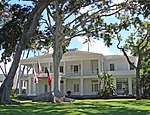Kauikeaouli Hale

Kauikeaouli Hale is a district courthouse for the Island of Oʻahu in Hawaii. It is located at 1111 Alakea Street between downtown Honolulu Hawaii and the Hawaii Capital Historic District at 21°18′32″N 157°51′31″W. Its lower floors house the courts of the first circuit, covering the City and County of Honolulu, and upper floors have offices of some support departments of the Hawaii Supreme Court. It is adjacent to the Hawaii State Art Museum. In the Hawaiian language, hale means "house" and Kauikeaouli was the birth name of the Kingdom of Hawaii’s King Kamehameha III (1813–1854). The art displayed at Kauikeaouli Hale includes: Aged Tree, a 1976 wood, copper and bronze sculpture by Satoru Abe Bear and Cubs, a 1973 black granite sculpture by Benny Bufano Hawaiian Mountain Series I, a 1974 ceramic sculpture by Bob Flint My Father's Eyes Have Seen What I Dreamed, a 1971 ceramic, wood and resin sculpture by Donald Harvey Family Structure, a 1971 wood sculpture by Ken Shutt
Excerpt from the Wikipedia article Kauikeaouli Hale (License: CC BY-SA 3.0, Authors, Images).Kauikeaouli Hale
South Hotel Street, Honolulu Hawaii Capital Historic District
Geographical coordinates (GPS) Address Phone number Website Nearby Places Show on map
Geographical coordinates (GPS)
| Latitude | Longitude |
|---|---|
| N 21.308888888889 ° | E -157.85861111111 ° |
Address
Hawaii State Art Museum
South Hotel Street 250
96813 Honolulu, Hawaii Capital Historic District
Hawaii, United States
Open on Google Maps








